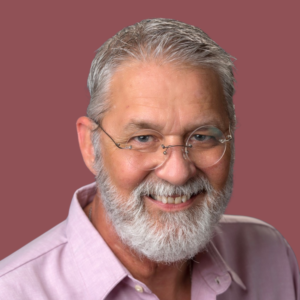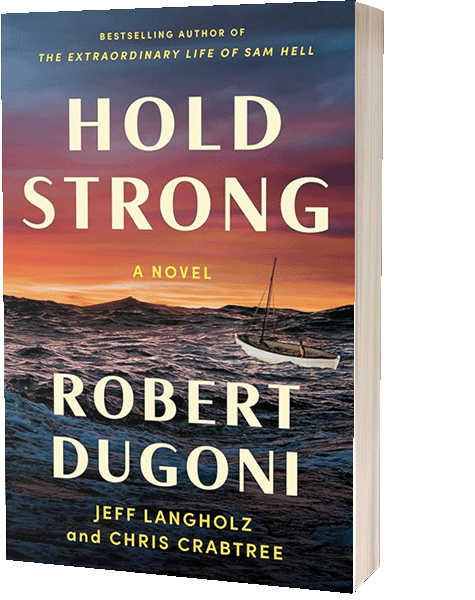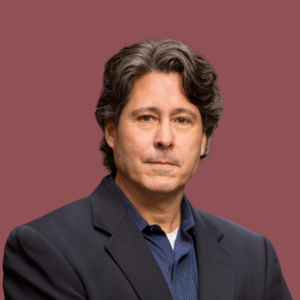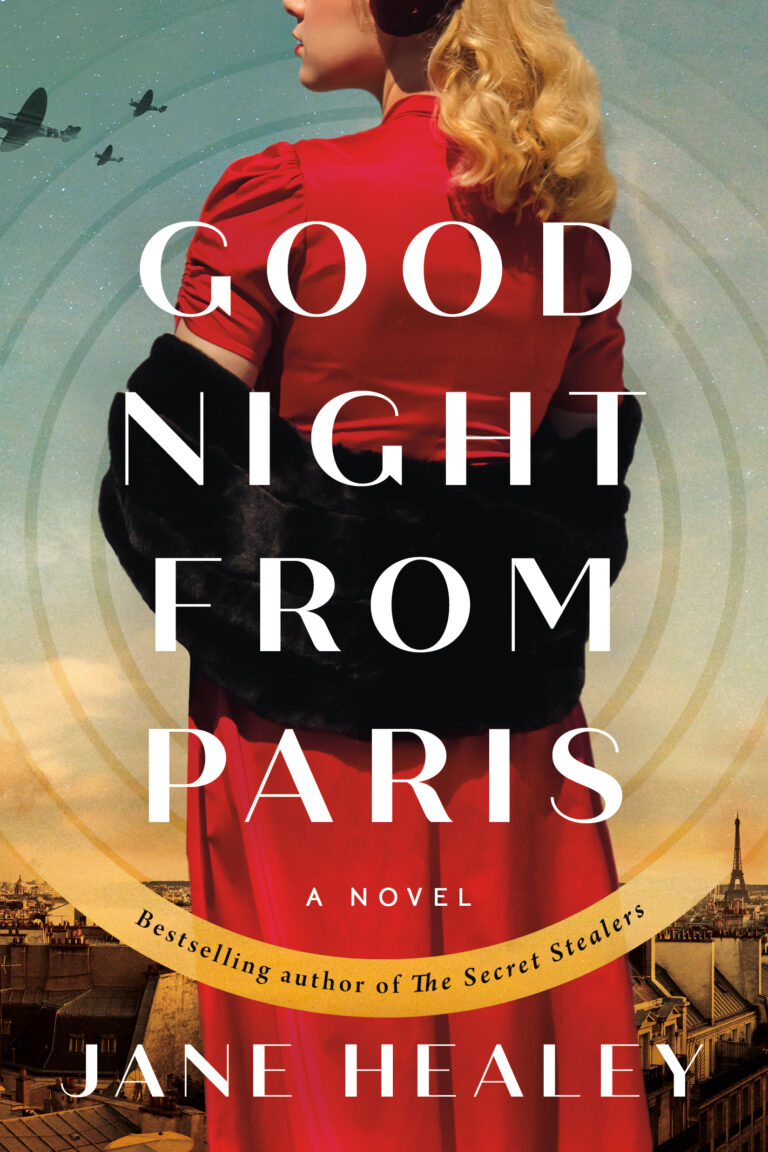[00:00:00] Jane: Welcome to Historical Happy Hour, the podcast that explores new and exciting historical fiction novels. I’m your host, Jane Healey, and in today’s very special episode, we welcome three authors who are helping me finally balance the demographic of my guests that I’ve had so many women on. It’s nice to have a couple guys on.
Thank you for doing this. Robert Dugoni, Jeff Langholz, and Chris Crabtree are here to discuss Hold Strong, the World War II novel they co authored about the deadliest accident in U. S. military history and the people that were involved. An incredible against all odds story. Again, Jeff and Bob and Chris, welcome and thank you so much for coming on to talk about this novel.
[00:00:41] Robert: Thank you for having us, Jane. It’s a pleasure.
[00:00:43] Jane: Thank you. So I’m going to try, I’m going to do a quick intro on all of you and then I will dive right into questions and then at the 20 25 minute mark we’ll take questions from the audience. Everyone remember you can put your audience questions in the chat or in the Q& A.
Okay, so it took a dream team of three writers to bring this story to the page. Chris Crabtree, who first uncovered this story and has personal connection to one of the real life heroes, Father Tom, who’s also a character in the novel. Jeff Langholz, a Middlebury professor and PhD, who dedicated more than a decade of research and investigation to the book, and Bob Degoni, the best, beloved best selling author and critically, beloved best selling and critically acclaimed author who consistently delivers resonant and character driven novels that balance drama, suspense, and poignancy.
Again, welcome and congratulations on this wonderful book. You’re welcome. So let’s dive in, Bob. There have been a lot of World War II novels over the decades. What makes this one so incredibly unique?
[00:01:47] Robert: The two guys that are on this show with me, to be honest the amount of research that they did is mind boggling.
I, Jeff was great about including many of the notes in the back of the book so that readers can follow what is true and they can look up stuff and do a bunch of things and go through it. But what he put in the back of the book is only a portion of the amount of research that they did. And so what they really uncovered was, I like to say it’s a little bit of.
It’s a Wonderful Life meets meets Code Breakers meets and now I’m drawing a blank on the on the third book oh, shoot Laura Hillenbrand, unbroken.
[00:02:29] Jeff: Unbroken. Unbroken.
[00:02:30] Robert: Unbroken.
[00:02:31] Jane: Yes.
[00:02:31] Robert: It starts out a little bit of It’s a Wonderful Life in a small town, two, two sweethearts, high school sweethearts.
One suspects he’s going to get drafted, so he joins the National Guard. The other is going off to college to major in math. And you have a really incredible love story. You have an incredible World War II story that really has never been told. The story of Japanese maroos. That, took so many prisoners the Philippines has been talked about, but not in great detail.
It’s a book that has a little bit of a little bit of something for everyone. It’s not a hardcore World War II novel, but at the same time we don’t pull any punches about what these prisoners of war went through on the baton death march, what they went through in the prisoner of war camps, what they had to do to survive on these hell ships.
Because we felt that, we owed it to them to tell their story. And I think Jeff and Chris can talk a little bit more about the individuals involved in this story that really motivated them to make sure that they got it right. And Chris really, I’ll pass it to Chris because he does a terrific job of telling the whole story of Father Thomas Sassina, who is truly not just a hero, but a remarkable human being.
[00:03:49] Jane: That was a great segue to my second question, actually. So thank you Chris, and you, it’s Father Tom Sassina. I want to make sure I pronounced that so he’s a character in the story and ultimately inspired the novel. You’re the one who started this whole project. What is your personal connection to Father Tom?
And how did you end up recruiting Jeff to the team?
[00:04:08] Chris: It, there isn’t a day in my life that I did not know the name Father Thomas Sassina. I’ve known that name from my first reckoning. I had three older brothers. I had already seen the template of my life. ahead of me. I was going to spend eight years at ST Simon the Apostle Catholic school on the east side of Indianapolis.
And I was going to spend four years of Father Thomas, the Senior Memorial High School. And so I always knew that that the school was named after a legitimate to hero. I knew that. But I did not know that the breath and depth of this human being’s character and each little thing that I found out about him only bolstered My eagerness to, to try to get his story out there in some way or another, and, I can remember talking to my mother even while I was working on the story and her mother my, my grandmother knew father Tom had been to masses that he said.
And in fact, my mom said that my grandma used to call him handsome father Tommy. And so it was It was just really important for me to be able to tell this story. I had a completely different story conjured in my head as to what this guy had endured during World War II. I was quite wrong about what it was.
And I felt just compelled to tell that story. And do you want me to go ahead and say how I got Jeff? That was almost a, that was almost a a strange set of circumstances itself. He was. Here in Costa Rica, where I live and teach visiting and I, we were sitting at a bar with no walls near the beach and I told him about this incredible Catholic priest and I was watching his face morph into pretty much confusion at first, shock and things like that.
And.
He said I’m gonna I almost want to pass it to him because I don’t want to say that he was embarrassed, but that’s sure what it looked like to me.
[00:06:23] Jeff: I’m sure I was embarrassed because here’s Chris. We’re sitting in this bar in Costa Rica. And he tells me this story from World War II that I’ve never heard before.
And I about spit up my beer. And I was so shocked. So I signaled to the bartender we’re gonna need another round here. Maybe multiple rounds. Chris, tell me this story. So he proceeded to tell me the whole story. And I was stunned. And as Chris said, I was embarrassed. Embarrassed because I studied history in college.
I even took an entire class on world war two, and I’d never heard of this chapter of these prison of war transport ships in the Pacific, these so called hell ships, and the reason POWs called them hell ships was because they were absolutely hellish experiences. 134 of these ships carrying over 100, 000 POWs around the Pacific with an extremely high death rate.
And I missed it. I’d seen like a lot of our audience today. I’ve watched all the World War II movies by Steven Spielberg and Tom Hanks and before them, John Wayne, Clint Eastwood. And I’ve read all the books like Unbroken and I thought, how did they miss this? Out of this incredible story slipped through the cracks and we decided we needed to try to share this with the world.
And we started working on it. This story found us and refused to let go. And it has gathered people along the way. And eventually, it found its way to Bob Degoni and attracted him as well.
[00:07:51] Jane: Excellent. I love that you met in a bar in Costa Rica. That sounds like it was just meant to be. Jeff, I have another question for you.
You did an incredible amount of research. during the middle stages. I want to read this quote. The research was long, hard, and at times exhilarating and took over a decade to piece things together. Talk about the meticulous research that you did for this story. I’m a research nerd. I love author notes, but these are above and beyond.
These author notes. And everyone who like loves research are going to just nerd out from the research notes in this.
[00:08:25] Jeff: Yeah, great. Thanks. I’m glad you’re a research nerd as well. Yeah. It was long and and grueling in many ways, but also exhilarating. The pieces of this puzzle that are spread around the world.
They are in the deep in the National Archives and declassified military documents. They’re in photographs. They’re in letters. They’re in stories passed down from survivors. They’re in China, a remote village in China, in the Philippines they’re spread all over the place. And to piece those together was quite a process, but it was also very exciting at times when we make an important discovery.
[00:09:00] Jane: Amazing. And so I do want to hear, Bob, how did you get pulled into this project?
[00:09:07] Robert: Initially I met Jeff He was in one of my writing classes called the Novel Writing Intensive and he submitted the first 50 pages and I said to him, I think this is, I think this is very good. I think this has really got a lot of legs.
If the rest of the book holds together, I could probably help you find an agent. And he said I already have an agent. And I said who is it? And he said, Meg Rooley. Who’s my agent and has been my agent for 30 years. And I said you’re in good hands. You don’t need anybody. And then I don’t know how long it was after that, but maybe it was a couple of years or maybe it was a year.
But basically the reason I got pulled in is because they had really crafted this really wonderful set of characters and story, but they wanted the writing to be at the same level of the research. And let’s face it. I don’t know if the level of writing could ever be at the same level of the research because the research is so amazing, but that was my task.
Was to do my best to make the characters come alive to make the reader care about the characters, you know Which is what we authors try to do when you close the book. We want the readers to be going Oh my god I wonder what happens next for Sam and for Sarah and I wonder what’s gonna go on and so that was really my task Beefing up Sarah making her a more prominent character in the book And I think that’s I think that’s really important for readers to understand Is this is not a war book, right?
This, there’s a very prominent character in in Sarah that runs throughout the story and, how she goes from being a math whiz, to joining the waves, to becoming a codebreaker and ultimately, all the stuff that, that goes along with what’s happening with Sam. I don’t want to give away any spoilers.
And I had the same reaction, I think, that Jeff had when he sat down with Chris the first time. When I finally had a chance to read the entire story, I had to keep reminding myself, my God, this is true. My God, this is true. This is amazing. And people ask me, what is the most amazing part of the book for you?
And the most amazing part of the book for me is when I found out from Chris that father Thomas has seen a, being a priest, he didn’t have to be there with the soldiers. He didn’t have to go on the baton death march. He didn’t have to be in the prisoner of war camps. He didn’t have to be on the hell ship.
He chose to be with those men to give them spiritual comfort and support. And wow. That’s the ultimate sacrifice, right? To lay down your life for others. And I was blown away by that really blown away. And I just thought I wanted this story to come to life. I felt for so many reasons that this story needed to be told and these two gentlemen needed the accolades that come with putting in that much work into a story.
[00:11:45] Jane: Amazing. I got chills when you talked about Father Tom, it’s just incredible. I want to talk about character development. You talk about Sam and Sarah, they’re the young couple from Minnesota in the center of the story. Their experiences during the war illustrate two vastly different aspects of World War II.
Sam’s horrific experiences in the Philippines and Sarah’s rise from math teacher to valued waved codebreaker. Talk about these two characters and how you created them. I know they’re not directly based on people. I know they’re composites of your research. So how did you come up with Sam and Sarah?
I’m going
[00:12:25] Robert: to let Jeff handle that.
[00:12:27] Jeff: I’ll start with Sam and then maybe Bob can talk about Sarah. Sam as you say is a composite, he’s on represents the US soldiers who served in the Philippines who went on the baton death march. Who spent two and a half years rotting in prisoner of war camps in the Philippines, and who are eventually crammed into the holds of these prisoner transport ships, the so called Hellships.
And then he represents a, an even smaller subset of that group as well. So Sam follows the typical hero’s journey. So does Sarah. Yeah, you’re an author. You’ve heard of the hero’s journey. They follow that trajectory quite a bit. But Chris and I, because it’s not hard to write characters that, that readers like.
It said Chris and I did that. They like Sam. They like Sarah. It’s, and you could even write characters who readers like a lot. And they do. But do they love Sam and Sarah? Not really. Which is where Bob comes in. I just gotta do a little Have you ever heard of the Extraordinary Life of Sam Hell? I’m sure some of your readers have.
I see them writing about it. People love Sam Hell. And if you want somebody to love your characters, rather than just like them Then that’s where Bob comes in. So Bob came in and took the characters to a whole new level, especially the code breaker, Sarah.
[00:13:40] Robert: Yeah. And my job. And before I say that, I don’t know if Chris and Jeff, if you’re looking at the chat box, but a guy by the name of Mark Stofa.
worked from Juneau, Alaska. He was in the Peace Corps with the two of you. He just came on and gave a nice note. So I just, if you’re not watching it, you should. I thought I write female characters. I write Tracy Crosswhite in the Tracy Crosswhite series and Keira Dugan in the Keira Dugan series.
And, I looked at the manuscript and I just said, my God, this woman, Sarah is just as fascinating as Sam. And I thought they had done a fabulous job of that. And really what my job was to show more of her home life. We open the book with Sarah at home and, we talk more about what the struggle that she’s going through, where she wants to do more for the war effort.
She wants to do more for Sam. And she feels constrained because so many women back then, that’s what they did, right? They went to college and they became teachers. There wasn’t a lot of other options for them. And this was a woman who’s incredibly bright, incredibly competent incredibly stubborn and, one of those women that’s ahead of her time.
She wants to do more. And boy does she she’s not going to take no for an answer. And so that’s really where we’re I came in and we all viewed this as a cinematic as a cinematic book, as I mentioned, it opens in a wonderful life. They’re living in this small town in Minnesota and then the world blows up and it blows up for everybody, and so we got a little bit of pushback on the ending. Our editors wanted to end the book earlier they felt that there was, the, and I just, I put my foot down, I said, no, these guys created a cinematic movie, Sam is a movie projector operator in Eagle Grove, and he’s showing stories about Ginger Rogers and Fred Astaire, and I said, that’s what this is, it’s a wonderful life, we need to have an ending that’s just as cinematic.
And the three of us really pushed for that and we won out and I think readers, I really enjoyed it. The AP, the Associated Press just gave us a review this week. And one of the things they said is this book is cinematic and could easily be adapted. And, that’s what we wanted.
We wanted a book that people looked at and they could think of all those movies they watched with their father or their mother or their families growing up. And that this would be one of those feel good stories, even though it’s a really difficult topic.
[00:16:01] Jane: I read that that AP review, and this brings me to a question that I was going to ask a little later on, because I also felt like it was very cinematic I could see the hero’s journey structure.
Has there been any talk of it being made into a movie or a limited series yet?
[00:16:18] Robert: Not yet. Not yet, but I have a lot of contacts in that field because I’ve had all my other books optioned and I would think that, I would think that studios would be crazy not to be bargaining to try to get this story and hire Jeff Langholz to be their executive producer because nobody knows more about this topic than Jeff.
[00:16:38] Jane: Excellent. I want, Jeff, this is probably a question for you. Back to the astonishing amount of research. It’s a work of historical fiction, but it includes, 400 research notes that track the true underlying story chapter by chapter. And huge bibliography. Why did you ultimately decide that this, you wanted to make this a novel and not, I get this question a lot too, and not write this as a nonfiction book?
[00:17:06] Jeff: We certainly thought about writing it as a nonfiction story from the beginning, Unbroken by Laura Hillenbrand. And full confession, we thought about doing a screenplay first and then we shifted towards novel. We coined a term called Screenville. Chris and I were calling it a Screenville.
It’s part screenplay, part novel. And we were following Blake Snyder’s Save the Cat, 14 beats, which are still all in there. And Robert McKee’s story principles for screenwriting. So it was a screenville at first, and then it shifted towards novel. But the reason we have all the documentation in there is in large part because the story, the underlying true story is so powerful and so unbelievable in many places that we thought people are not going to believe this.
They say truth is stranger than fiction. It is stranger and better. And our job was to get out of the way. And then just document so that people would believe that when something miraculous happens in the true story, we cite the source that says, Yep, this really happened. And so that’s why we have 470 some end notes.
If readers want to follow the true underlying story chapter by chapter. They can. We live at a time when authors like to claim that their stories are based on a true story or inspired by true events because it helps them sell more books. And we wanted to back that up with transparency.
[00:18:26] Jane: Excellent. These next questions I have are more about the writing process. I asked all the authors that are on here. The first one is how did you strike a balance? And the question is, because this is such a fact heavy story, right? Research heavy story. How did you strike a balance between historical fact versus fiction in telling this story?
And were there any strict rules that you adhered to?
[00:18:49] Robert: So I’ll answer quickly first. I would, when I was doing my edits Jeff and Chris would look at it and Jeff would say Bob this all looks good. However, you cut out five lines of dialogue. And I said I just felt that the story needed to move a little faster and he’d say, yeah, but those lines of dialogue can be documented in these documents that I have that this is what the men actually said.
And I went, oh, okay, let’s put them back in. Part of my job was just trusting the two, these two gentlemen, trusting the research they did. And and trying to be true to it
[00:19:25] Jane: went. I know this next question is about working collaboratively. I’ve interviewed, I’ve talked to co authors, Kate Quinn and Janie Chang, most recently, Allison Richmond and Shawna Edwards.
But this is the first time I’ve talked to 3 people who collaborated on a novel, this massive project together. How did you, how’d you figure it out? What was and what was the, yeah. That’s part of the process. And what was the most challenging
[00:19:54] Chris: I think I’ll jump in. Just for your listeners who are writers. How hold strong was written is not a template for a collaboration probably in any way, shape or form. Jeff and I both try to be very excellent in our day jobs. And we Pat literally passed past word documents back and forth through messenger and built upon each little brick that that we would write.
And then Jeff quarterback the team and put these bricks in the right order. So sometimes he would send me, he would send me, maybe an assignment for instance, like we need about 500 words on this or 1400 on that. And we pass these things back together and pieced it pieced it together like a puzzle.
But I think that there was a joy in doing it that way and add to it that Jeff and I are longtime friends. We met in the United States Peace Corps back in the mid eighties. This is a a brother to me and in every way that definition can be handled. So we trust each other very much and love each other very much.
And it was it was an easy collaboration in that regard. But it’s certainly not like a how to how to collaborate and make a novel for you and your friends.
[00:21:13] Jeff: I’ll just chime in on that as well. Chris and I hit the baton back and forth. We like to joke that today with modern technology, there are all these wonderful online collaboration tools that teams can work together across time and space halfway around the world, and we used absolutely none of those.
We just patched the document back and forth. And then Chris and I passed out the baton back and forth, but after several years, to full disclosure here, we were getting tired of running laps around the track, carrying the baton, and we’re, there was some doubt among our team if we’re going to get this thing across the finish line.
And so we’re like, handed the baton off to Bob Dugoni, and we’re like, Bob run, Bob, and then Bob took off with it.
[00:21:54] Jane: Excellent. Oh, I okay. So these next couple questions I think are for you, Bob. And then if you have questions, please put them in the chat or in the Q and a so Bob, I asked this question to every author that comes on.
You are so prolific. There’s lots of love for your books in the chat. I think you’ve seen some of that. What are you a plotter? Are you a pantser? What’s your process? I’m so curious to know.
[00:22:18] Robert: So I think it’s important for I think it’s important for your readers that I give a preface here because I know some of them are writers.
When I started out I was a plotter. The problem was, within about three days, I was off my plot and the book was going and writing itself. I have taken 30 years to study story structure. To study Christopher Vogler’s book, The Writer’s Journey, to study Saul Stein’s book, On Writing, to study Save the Cat.
And understand how a story is put together. And so when I teach the Novel Writing Intensive, I tell my students, You can call yourself an artist and you don’t want to follow any pattern. And there’s a wall over there that you can also go bang your head against because that’s what’s going to happen.
You’re going to, you’re going to have a massive headache. Learn story structure. Learn how stories are told. And so I say that as a preface because I don’t outline, okay? I don’t. I many years ago when I was let go by Simon Schuster, after my David Sloan series, I took some time to re evaluate the writing process.
I read Stephen King’s book on writing, and Stephen King says, how does an author sitting at her desk touch the heart and soul of a person she’s never met and never will living in a town she’s never visited and never will? And his answer was telepathy. And at first, I didn’t have any understanding of what he was talking about.
And then when I started to realize what he was saying, which was, listen to your characters. Let your characters come alive, and let them tell you the story. Because they have a story to tell. And your job is to transcribe what they’re telling you, and let it go. And don’t write with anyone sitting on your shoulder.
Not your mother, not your wife, not your husband, nobody. Just write it raw and unfiltered and honest. And if you do that, you will have created a story that has legs. And that’s really what I do now.
[00:24:15] Jane: Excellent, and that’s excellent advice. And Lee, you’re making my job easy tonight. That leads me to my next question, actually.
And to your point about structure, too, I think I would, it took me ten years to write my first novel, and had I paid a little bit of attention to structure, it might have taken me half that time. Maybe not, but I always talk to young writers, new writers, I’m always like structure, it is your friend, it is not just pay attention.
To that end, what is some other advice that you often give aspiring authors about writing and getting published? I know those are two very different things.
[00:24:49] Robert: So structure is really the big one. The other thing that I always say to my students is never lose sight of the fact that no one is holding a gun to your head.
No one is telling you, you have to sit at a desk and write the story. You do it because you feel like you have a story to tell, or hopefully you do it because you love storytelling, and this is what you love to do. But don’t lose sight of the fact that there’s so much more to us as human beings than what we do for a living.
I’ve told this story many times. In 2016, I had a stroke, and I ended up in the hospital. And I can tell you, I, I didn’t care what, if I published another novel or sold another novel in my entire life, all I cared about was getting better for my wife and my kids. And I think it was a great gift that God gave me, which was perspective.
And I always tell my students, don’t lose your perspective, right? There are bigger things in this world than getting a book published. And those bigger things are the people that you love and who surround you. And who you bring into your life. If you are blessed to get a book published, then my God, go celebrate and celebrate with the people you love because it’s their accomplishment as much as it’s yours.
[00:26:11] Jane: Absolutely. All good advice. Actually this, I’m going to start taking questions from the audience and this is a perfect segue. Once again what did y’all do to celebrate completing this book and getting it out into the world? I know you’re, you couldn’t go to a bar together because you’re all in different places right now.
So what did you do? Chris, do you want to go first?
[00:26:33] Chris: Yeah, sure. We, we did an online toast with the whole team, which now looks like the, Hollywood squares. I’m definitely the one that’s separated from from the balance of the group. I have a fairly non exciting existence.
My wife and I live in a small rural town with our dogs and So she and I spent some contemplative moments together. I, there was a lot of relief that I felt that the journey, the work that we put into this was finally going to, this drive that we had to get this story told correctly, that it was finally coming to that.
And Yeah, so not exactly a drop the mic, spike the football thing, but we we were very contemplative and probably humbled by the whole thing.
[00:27:22] Jane: Amazing. How about you, Jeff? How’d you celebrate?
[00:27:26] Jeff: Oh, I think like Chris mentioned, we did have a wonderful event online via Zoom last Tuesday on our publication day, and it was just so heartwarming to see all the team members.
At the, at our agency and the the publisher, our publicist, Megan and others the three coauthors all on board and just celebrating this moment that had been so long in the making. And so we’re just thrilled. We’re thrilled with the response even stunned with the reader’s response to the book so far.
Chris used the word relief. I’m going to add that in there as well. Relief. This story found us and refused to let go and it attracted the right people to get out into the world and we had a responsibility to tell the story as well as we possibly could. And I feel like, okay, we did. We told it.
Okay, we did. All right.
[00:28:13] Jane: Yeah. Yes. And Pierpont asks, and I think I know this answer. How long in total did it take you from like conception of the idea to finishing the story, finishing the book? How long was this whole process?
[00:28:27] Jeff: The whole process, the story, that bar scene with Chris told me the story and about spit out my beer.
That was April 2013. So we’re coming up on 12 years, but I’m you think I’m a geek keeping track of the sources for the story. I’m also a geek for keeping track of my time, how much time I spend on various things that those 12 years, if you condense the hours it ended up being about two hours of full time work.
Two years, two years of full time work. I don’t know about the other guys, how much time they spent.
[00:28:57] Chris: I don’t track time.
[00:28:59] Robert: Yeah I would be afraid to track that. I’m a bit of a workaholic, a bit OCD which is why I’m now OCD about golf. But I felt I felt a lot of pressure to be honest with you.
People have asked me, would you do this again? And I said I’ve loved the experience with Chris and Jeff, but boy, it was a lot of pressure. I felt that pressure of doing right by these two men, making sure that the story remained their story. I didn’t want to take over the story.
I, I wanted it to be a Bob Digoni book because I wanted readers to fall in love with the characters and all those things. But I wanted to be, I wanted to be I don’t know what word I’m looking for, but I’ve gained so much respect for them that I wanted to be sure that people knew and understood that this was really their novel.
This was really their story. And I was just there, as Jeff said, to get it out into the world. And get it across the finish line. So that was there was a lot of pressure. I’ll be honest. There were times where I was like oh, my. Oh, boy. Oh, boy.
[00:29:58] Chris: We’re so absolutely grateful for what it has become.
It is a weighty story, just the sheer weight of trying to to honor these people. It’s the greatest generation for all the right reasons. And, there were there were 1800 plus voices stories that got extinguished that day that we don’t get to hear. And so we were able to piece it together from the voices of the few who have survived these these terrible incidences.
And wow, carrying that around reminds all of us of the Maya Angelou. of the agony of carrying the untold story. And so I think that we all felt the gravity of what it is that we were doing and just so grateful that the team came together in the same, in, with a common common attitude to get it out there for people to consume.
[00:30:49] Jane: Yeah, I will say, I think that the European theatre in fiction, the European theatre of operations in World War II has been covered many times in fiction, and I think that the Philippines, the Pacific theatre, not as much, and this story, I had never heard of it, and I’m sure a lot of people who come across your book will feel the same way, and one thing, I had notes about that, what these men endured, In the march, I’m gonna get choked up, and the, and on that ship, it was, it’s unimaginable, like I just, it just, it takes your breath away, how horrible it was, and and and you balance that with, going back to Sarah’s life as well, and, but it was, yeah, it was unimaginable, and it’s shocking that more people don’t know the tale, I’ll be honest, yeah.
[00:31:35] Robert: Jane, I’ll give you a good example of why this book is so important and so special for so many reasons. I lost a good friend named Jeff Behrman about a week before Christmas and went to went to his funeral. And the next, his mother was there, Carol, and Carol always got my books and took them to her retirement community.
And I said, Carol, come by the house tomorrow and I’ll give you another stack of books. And she said she would. And so here’s this woman who’s just lost her son and she comes to the house and she comes into my room and I, and she said, I have to be honest with you. I can’t read your mysteries. They’re too scary.
And I laughed and I said, okay, that’s okay. I said, I have another book for you. It’s a world war two story. And she said, Oh, Bob, I can’t read World War II stories. I lost my dad in World War II. I said, Oh, Carol, I’m so sorry. What happened to him? And she said he grew up in Ohio and as the war was coming, he feared being drafted.
So he joined the National Guard and then FDR federalized the National Guard and he got sent to a tank division at Fort Knox and then he got shipped out to Tacoma and he was in a tank division in Tacoma and then he got shipped to San Francisco. Then he was put on the SS Calvin Coolidge. And he was sent to the Philippines, and the Philippines got overrun.
He was in the Bataan Death March, and then he was in the prisoner of war camps. And after that, we don’t know what happened to him. And I said, Carol, I think I do. So I got ahold of Jeff by email. I said, here’s his name. Can you tell me what happened to him? And Jeff may call himself a nerd, but this nerd gave this woman the greatest gift she could ever have, which was he told her your father was on this ship and he survived.
And then he was put on this ship and he died and he was buried at sea. So in, in the span of one day, this woman lost her son.
[00:33:26] Jane: That is, I’m sorry for your loss. And that’s an unbelievable story. Unbelievable. So I’m like, I need a moment. That’s unbelievable. I’m really sorry. I want, I, one question I didn’t ask of all of you, how can readers best stay in touch with you and will you be doing future events, whether via zoom or in person?
In the coming year.
[00:33:49] Robert: I think we all I have a website, obviously. But if you really mine is just www. robertdogronian. com. But if you really want to know more about this story and more about this book, you need to go to jefflangholz. com. His website, he has done an incredible amount, put an incredible amount of work up there, and people can go in, and it’s a little bit interactive, and it’s informative, and it’s just, it’s a great I highly recommend that readers do that.
And it’s, yeah it’s an amazing experience.
[00:34:19] Jane: Excellent. One more question from the audience. And actually, this is one that I was going to ask and I missed. What in the research, was there a single shock? This is from Mary Worthington. Was there a single shocking discovery that stood out to you?
Or was there so much to cover, uncover that you can’t name one, one single thing? I, yeah, I was also curious about did you come across something that just changed the narrative? Because it was so shocking.
[00:34:44] Jeff: I’ll take a stab at that one. The answer is yes. There were a couple of needle needles in the haystack that we were looking for, and we found those.
Those were I don’t know, needles in the haystack or smoking guns. The declassified military documents. One of them was a three by five index card. That was our intercepted Japanese radio message where the code breaker had listened to the message, deciphered it, decoded it, translated from Japanese into English.
Typed it up on a three by five index card. There were thousands of these and this was the needle in the haystack that really changed how we wrote the story. And then another one was uncovered at the MacArthur Memorial and Archive in Virginia. It was a message from a guerrilla group in the Philippines fighting Japanese MacArthur’s headquarters in Australia saying, Hey, There’s a boat that just left Manila.
It’s got like 2000 American POWs crammed into the holes. Just wanted to let you know that. And so these two needles in the haystack changed how we wrote the story.
[00:35:47] Jane: Amazing. Amazing. So I think we’re going to wrap this up. This was. Incredible. I love chatting with all of you. Thank you for taking the time.
I know the book just launched. I’m going to hold it up again. Everyone should read it. It’s a great book club book. There’s so much in here. Whether you’re, you’re a huge World War II fan or just historical fiction fan, there’s just so much for everyone. Thank you again to the three of you for coming on.
Thank you, everyone, for showing up tonight. And next up on February 12th, I have Suzanne Nelson to discuss her novel, Librarians of Lisbon. And just a reminder that my Cold War novel, The Women of Arlington Hall, is available for pre order and releases this summer. Again, thank you. I love the story and it’s such an important story to get out there.
And I wish you the best of luck with it.
[00:36:34] Jeff: everyone.
[00:36:35] Jane: Have a wonderful night. Thank you. Take care.






